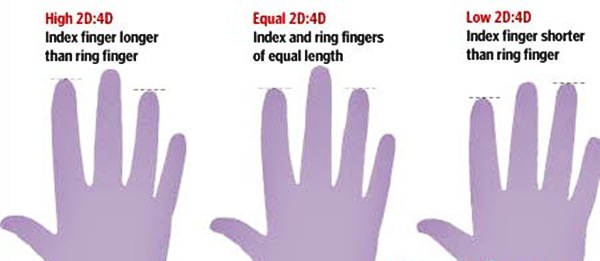

The authors have attempted to write a brief account on the digit ratios and the dimorphism observed in various physiological, psychological and behavioural traits. Prenatal androgen exposure and therefore, digit ratios have been reported to be associated with numerical competencies, spatial skills, handedness, cognitive abilities, academic performance, sperm counts, personalities and prevalence of obesity, migraine, eating disorders, depression, myopia, autism etc. Usually, males have lower ratios when compared to females. Digit ratio (2D:4D), comparing the length of the index finger to the length of the ring finger, is a sexually dimorphic trait with males displaying, on average, a lower digit ratio than females ( Manning and Fink, 2008 Hnekopp and Watson, 2010 ). Interestingly, it is constant since birth and not influenced by the adult hormone levels. The term describes the relationship between the length of the second (2nd digit, 2D, or index) and the fourth (digit 4, 4D, or ring). A longer ring finger compared to your index finger is considered a low 2D:4D ratio. So if your index finger is 2.9 inches long and your ring finger is 3.1 inches long, you have a 2D:4D ratio of. Ratio of 2D:4D is found to correlate negatively to testosterone and positively to oestrogen in the foetus. 2D stands for second digit that’s your index finger, and 4D means fourth digit your ring finger.

Existing literature and recent research show accumulating evidence on 2D:4D ratio showing correlations with various phenotypic traits in humans. All rights reserved.Digit ratios, especially 2D:4D ratio, a potential proxy marker for prenatal androgen exposure shows sexual dimorphism. Results have important implications for the design and interpretation of studies which use 2D:4D as a proxy measure of prenatal testosterone exposure.Ĭopyright © 2011 Elsevier Inc. No significant relationships were observed when salivary testosterone and CAG repeats were examined independent of each other. No significant relationships were observed within females. 2D:4D has been shown to predict success in highly competitive sports. This suggests that 2D:4D in adults may reflect, in part, neonatal testosterone exposure. The second-to-fourth digit length ratio (2D:4D) has been proposed as a marker of these prenatal androgen effects, a relatively longer fourth finger indicating higher prenatal androgen exposure. The interaction of salivary testosterone and CAG repeat length also predicted change in left hand 2D:4D from 2 weeks to 12 months in males. Introduction 2D:4D ratio is the length of someone’s index finger divided by the length of their ring finger on the same hand. In addition, the interaction of salivary T and CAG repeats predicted right hand digit ratio at 12 months and left hand digit ratio at 12 months and 24 months in males. This suggests that 2D:4D may not function well as a proxy measure of prenatal testosterone exposure in infancy.

Sex differences were small compared to adults and did not consistently reach statistical significance. The ratio of 2nd to 4th digit length: a predictor of sperm numbers and concentrations of testosterone, luteinizing hormone and oestrogen. There was substantial variability across age in 2D:4D. In addition, 259 children provided DNA samples which were genotyped for the CAG repeat polymorphism in the androgen receptor. Saliva samples were collected from 236 of these children 3 months after birth and analyzed for testosterone. We collected 2D:4D ratios from 364 children between 0 and 2 years of age. The relative lengths of the 2nd and 4th digits (2D:4D) may provide an easily measurable and stable anthropometric index of prenatal androgen exposure, but no study has examined the development of 2D:4D in infancy and the potential impact of neonatal testosterone levels.


 0 kommentar(er)
0 kommentar(er)
